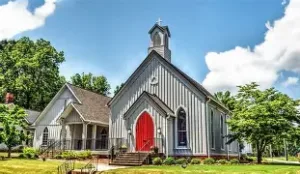Episcopal Church of the Ascension
Ascension’s Birth: First Third of Life
On Ascension Day of the church calendar, a breezy evening late in May, the tiny gray church with the red doors kicked off its 175thbirthday celebration. Considering its humble beginnings, to have survived for this long may be a miracle.
Today the Episcopal Church of the Ascension is located on West Cherokee Avenue in Cartersville, but it began on the Etowah River. Following close behind the Native American removal and Anglican evangelism in the colonies, first Episcopal Bishop of Georgia Stephen Elliott traveled in 1844 to the Etowah to visit his friend William Henry Stiles. Savannah native, Congressman, and Ambassador to Austria, Stiles and other friends of the church encouraged Elliott to form a parish “in this most interesting country.” By June of 1845, the bishop consecrated a church near Valley View plantation and a parsonage and school on forty acres across Euharlee Road.
Tough Times
“The 1844 church was serviced by a circuit rider ministry and subject to conditions of the time, weather and transportation as examples,” businessman and third-generation Ascensionite Guy Parmenter explains. Considering the difficulty, new settlers didn’t travel much. Stiles descendant Frederick Knight said, “The Stiles family were very devout Episcopalians and led Morning Prayer and perhaps Evening Prayer every day in their households. But they didn’t go into town often like we do.” Church attendance would likely have been affected as well.
Ascension’s rector—when one was available–often served up to four mission churches from those in Kingston, Cassville, Cartersville, Cedartown, Cave Spring, Dalton, Rome, and Calhoun. From that list, missions in Kingston, Cassville, and Cave Spring no longer exist. Both the Civil War—which devastated the mission in Cassville—and Reconstruction provided obstacles for the entire population, but especially for mission churches hanging on by a thread. Kingston’s mission was listed as dormant by 1907, and Cave Spring’s by 1938.
Hanging in There
Ascension, however, has survived into the twenty-first century. What helped the small church endure? Partly it was the support of community leaders migrating from Savannah and elsewhere. Among others, William Henry Stiles, W.H. Stiles, Jr., his son W.H. Stiles, III, as well as his son Robert Mackay Stiles, and his daughter Margaret Stiles Knight were church leaders throughout the late 1800s, 1900s, and 2000s. And Parmenter said that his parents and grandparents, who came in 1929, “contributed heavily both in time and money to the betterment of Ascension.”
Ascension also survived sporadic clergy leadership by having the liturgy itself. Referred to by some as ritual, liturgyis the group response to and participation in the sacred, from the Greek word liturgiameaning the people’s work for the common good. According to the Very Reverend Mary K. Erickson, rector since 2010, liturgy is key to emphasizing “the role of the people over and above the role of the clergy. It is important to have an ordained person, but regardless . . . it is the community that gathers that really matters.”
Community Support and Growth
Another factor that helped the church survive is flexibility. In the early 1870’s, the congregation relocated to the growing town of Cartersville. They chose a “Carpenter Country Gothic” design for the building, but finances—difficult for many during Reconstruction–plagued the building project, halting construction during 1873. Nevertheless, the community of Cartersville supported Ascension with a December 1873 fundraiser, advertised in the newspaper thusly: “The Episcopal church ought to be finished. It will be an ornament to the city.” With financial help from near and far, the building was completed and consecrated in 1874. The historic sanctuary still houses the congregation today. According to Knight, “I don’t know anybody who doesn’t love that church.”
Though the church struggled, it often prospered with changes and growth intermittently through the late 1800s. The Rev. George E. Benedict in 1892 reported 17 families and 79 individual members as well as updates of gas lights and aisle carpet. Under Rev. F.W. Ambler—also of St. Andrews in Kingston–the church built a rectory in 1900, located directly behind the church in the current parking lot.
From 1868 till 1890, the Diocese of Georgia observed growth from 31 churches to 53 churches and chapels, with five missions added, according to diocesan records. By 1892 discussion began for dividing the diocese for better oversight. This finally occurred in 1907, with the creation of the Diocese of Atlanta, which spans from Columbus and Macon north, including Ascension in its territory.
From the vantage point of its 175thbirthday, the tiny gray church with the red doors hardly resembles the one born in the 1800s. The struggles of the pioneer founders seem a distant dream, though the motto of the celebration ensures that Ascension retains flexibility while it remembers its roots: Honor the past, celebrate now, forge our future in Christ.

